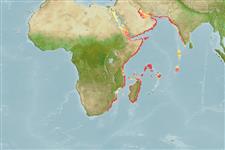Teleostei (teleosts) >
Kurtiformes (Nurseryfishes, cardinalfishes.) >
Apogonidae (Cardinalfishes) > Apogoninae
Etymology:
Environment: milieu / climate zone / depth range / distribution range
Ecology
Marine; demersal; depth range 0 - 2 m (Ref. 122824). Tropical; 30°N - 30°S, 31°E - 67°E
Western Indian Ocean: from Egypt, Suez, south to northern Durban South Africa and east to Pakistan. Migrated to the Mediterranean through the Suez Canal (Ref. 5385, 93646).
Size / Weight / Age
Maturity: Lm ? range ? - ? cm
Max length : 9.5 cm TL male/unsexed; (Ref. 127374); max. published weight: 20.00 g (Ref. 127374)
Life cycle and mating behavior
Maturities | Reproduction | Spawnings | Egg(s) | Fecundities | Larvae
Eschmeyer, W.N. (ed.), 2003. Catalog of fishes. Updated database version of March 2003. Catalog databases as made available to FishBase in March 2003. (Ref. 46206)
IUCN Red List Status (Ref. 130435)
Threat to humans
Harmless
Human uses
Tools
Special reports
Download XML
Internet sources
Estimates based on models
Preferred temperature (Ref.
123201): 24.6 - 27.6, mean 26.8 °C (based on 122 cells).
Phylogenetic diversity index (Ref.
82804): PD
50 = 0.5000 [Uniqueness, from 0.5 = low to 2.0 = high].
Bayesian length-weight: a=0.01122 (0.00528 - 0.02384), b=3.10 (2.92 - 3.28), in cm total length, based on LWR estimates for this (Sub)family-body shape (Ref.
93245).
Trophic level (Ref.
69278): 3.4 ±0.5 se; based on size and trophs of closest relatives
Resilience (Ref.
120179): High, minimum population doubling time less than 15 months (Preliminary K or Fecundity.).
Fishing Vulnerability (Ref.
59153): Low vulnerability (10 of 100).
